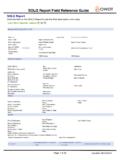Transcription of NAVAL POSTGRADUATE SCHOOL
1 NAVAL POSTGRADUATE SCHOOL MONTEREY, CALIFORNIA THESIS Approved for public release; distribution is unlimited MARINE AVIATION WEAPONS AND TACTICS SQUADRON ONE (MAWTS-1): SLEEP, FATIGUE, AND AVIATOR PERFORMANCE STUDY by Pamelyn L. Maynard December 2008 Thesis Advisor: Nita Lewis Miller Second Reader: Susan M. Sanchez THIS PAGE INTENTIONALLY LEFT BLANK i REPORT DOCUMENTATION PAGE Form Approved OMB No. 0704-0188 Public reporting burden for this collection of information is estimated to average 1 hour per response, including the time for reviewing instruction, searching existing data sources, gathering and maintaining the data needed, and completing and reviewing the collection of information.
2 Send comments regarding this burden estimate or any other aspect of this collection of information, including suggestions for reducing this burden, to Washington headquarters Services, Directorate for Information Operations and Reports, 1215 Jefferson Davis Highway, Suite 1204, Arlington, VA 22202-4302, and to the Office of Management and Budget, Paperwork Reduction Project (0704-0188) Washington DC 20503. 1. AGENCY USE ONLY (Leave blank) 2. REPORT DATE December 2008 3. REPORT TYPE AND DATES COVERED Master s Thesis 4. TITLE AND SUBTITLE Marine Aviation Weapons and Tactics Squadron One (MAWTS-1): Sleep, Fatigue, and Aviator Performance Study 6.
3 AUTHOR(S) Pamelyn L. Maynard 5. FUNDING NUMBERS 7. PERFORMING ORGANIZATION NAME(S) AND ADDRESS(ES) NAVAL POSTGRADUATE SCHOOL Monterey, CA 93943-5000 8. PERFORMING ORGANIZATION REPORT NUMBER 9. SPONSORING /MONITORING AGENCY NAME(S) AND ADDRESS(ES) N/A 10. SPONSORING/MONITORING AGENCY REPORT NUMBER 11. SUPPLEMENTARY NOTES The views expressed in this thesis are those of the author and do not reflect the official policy or position of the Department of Defense or the Government. 12a. DISTRIBUTION / AVAILABILITY STATEMENT Approved for public release; distribution is unlimited. 12b.
4 DISTRIBUTION CODE A 13. ABSTRACT (maximum 200 words) The Weapons and Tactics Instructor (WTI) course conducted at the Marine Aviation Weapons and Tactics Squadron One (MAWTS-1) command in Yuma, Arizona is considered the capstone of Marine aviation training. Concerned about its high aviation incident rate, MAWTS-1 leadership asked the NAVAL POSTGRADUATE SCHOOL (NPS) to assess whether student sleep is a contributing factor. In a baseline study at MAWTS-1, the students were found to be chronically sleep deprived. Six months later, this thesis effort gathered sleep data on 20 WTI 1-06 student pilots using wrist activity monitors and activity logs.
5 Results showed the mean nightly sleep to be significantly higher than the baseline study, possibly caused by the implementation of a Tactical Risk Management course. Unlike their predecessors, the students in WTI 1-06 were not sleep deprived. As a result, no significant correlations were seen between sleep quantity and quality and student performance, as measured by exam and flight scores, or between predicted effectiveness and performance, as generated with the Fatigue Avoidance Scheduling Tool (FAST) program. While other variables were found to be slightly correlated with performance, several issues were identified that may have affected these results, along with recommendations for improving future studies.
6 15. NUMBER OF PAGES 123 14. SUBJECT TERMS Cumulative sleep loss, fatigue, pilot, Marine Aviation Weapons and Tactics Squadron One, Weapons and Tactical Instructor, fatigue countermeasures, predicted performance 16. PRICE CODE 17. SECURITY CLASSIFICATION OF REPORT Unclassified 18. SECURITY CLASSIFICATION OF THIS PAGE Unclassified 19. SECURITY CLASSIFICATION OF ABSTRACT Unclassified 20. LIMITATION OF ABSTRACT UU NSN 7540-01-280-5500 Standard Form 298 (Rev. 2-89) Prescribed by ANSI Std. 239-18 ii THIS PAGE INTENTIONALLY LEFT BLANK iiiApproved for public release; distribution is unlimited.
7 MARINE AVIATION WEAPONS AND TACTICS SQUADRON ONE (MAWTS-1): SLEEP, FATIGUE, AND AVIATOR PERFORMANCE STUDY Pamelyn L. Maynard Lieutenant, United States Navy , Arkansas State University, 2000 Submitted in partial fulfillment of the requirements for the degree of MASTER OF SCIENCE IN HUMAN SYSTEMS INTEGRATION (HSI) from the NAVAL POSTGRADUATE SCHOOL December 2008 Author: Pamelyn L. Maynard Approved by: Nita Lewis Miller Thesis Advisor Susan M. Sanchez Second Reader James N. Eagle Chairman, Department of Operations Research iv THIS PAGE INTENTIONALLY LEFT BLANK vABSTRACT The Weapons and Tactics Instructor (WTI) course conducted at the Marine Aviation Weapons and Tactics Squadron One (MAWTS-1) command in Yuma, Arizona is considered the capstone of Marine aviation training.
8 Concerned about its high aviation incident rate, MAWTS-1 leadership asked the NAVAL POSTGRADUATE SCHOOL (NPS) to assess whether student sleep is a contributing factor. In a baseline study at MAWTS-1, the students were found to be chronically sleep deprived. Six months later, this thesis effort gathered sleep data on 20 WTI 1-06 student pilots using wrist activity monitors and activity logs. Results showed the mean nightly sleep to be significantly higher than the baseline study, possibly caused by the implementation of a Tactical Risk Management course.
9 Unlike their predecessors, the students in WTI 1-06 were not sleep deprived. As a result, no significant correlations were seen between sleep quantity and quality and student performance, as measured by exam and flight scores, or between predicted effectiveness and performance, as generated with the Fatigue Avoidance Scheduling Tool (FAST) program. While other variables were found to be slightly correlated with performance, several issues were identified that may have affected these results, along with recommendations for improving future studies.
10 Vi THIS PAGE INTENTIONALLY LEFT BLANK viiTABLE OF CONTENTS I. A. BACKGROUND ..1 B. OBJECTIVE ..2 C. LIMITATIONS AND ASSUMPTIONS ..4 D. HUMAN SYSTEMS INTEGRATION (HSI) ..4 E. THESIS ORGANIZATION ..6 II. LITERATURE REVIEW ..7 A. SLEEP ..7 1. Sleep Debt and Its 2. Homeostasis and Circadian Rhythms ..9 3. Stages of Sleep ..11 4. Sleep and Memory ..13 B. FATIGUE ..15 1. Fatigue Effects on Aviator Performance ..16 C. AVIATOR SLEEP REQUIREMENTS ..18 1. United States a. United States Navy and United States Marine Corps ..18 b. United States Air c. United States d. United States Coast 2.















